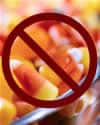- Science & Research
- Science News
- Newsletter
- 2006
- October 31

Newsletter
Newsletter
Silymarin improves diabetic blood values
 | ||||||||||||||||||||||||||||||
| ||||||||||||||||||||||||||||||
| ||||||||||||||||||||||||||||||
| Life Extension Update Exclusive Silymarin improves diabetic blood values An article published online in the journal Phytotherapy Research revealed that silymarin, an extract of the seeds of the milk thistle plant, helped lower blood sugar, glycosylated hemoglobin, and other abnormally elevated blood values in diabetics. In a randomized, double-blind trial, Fallah Huseini of the Institute of Medical Plants and his colleagues at Tehran University of Medical Sciences in Iran administered 200 milligrams of silymarin three times per day for four months to 25 type II diabetic patients, while 26 diabetics received a placebo. All participants continued their oral hypoglycemic drugs throughout the trial. Blood levels of fasting glucose, glycosylated hemoglobin (sugar bound to hemoglobin, which reflects long term glucose control), insulin, total cholesterol, HDL, LDL, triglycerides, and liver enzymes SGOT and SGPT were measured before the trial and at its conclusion. Dr Huseini and colleagues found that the subjects who received silymarin experienced a significant reduction in fasting blood glucose, glycosylated hemoglobin, total cholesterol, LDL, triglycerides, SGOT and SGPT levels compared to the placebo group’s values, as well as in comparison with pretrial levels. While average fasting blood glucose dropped from 156 milligrams per deciliter to 133 milligrams per deciliter among those who received silymarin, participants who received the placebo experienced an average increase of 11 milligrams per deciliter by the end of the treatment period. Glycosylated hemoglobin, total cholesterol, and triglycerides also decreased among those receiving silymarin while increasing among the placebo group. No side effects were reported in association with silymarin. Although it is not clear how silymarin works to benefit diabetics, its antioxidant properties may help lower some of the oxidative stress caused by elevated glucose and free fatty acid levels. Previous studies with silymarin have found that the compound reduced insulin resistance and the need for insulin therapy in diabetics. Additionally, silymarin’s ability to protect the liver and correct liver function may benefit lipid and glucose metabolism. "We don't know the exact mechanism of action for this effect, but this work shows that silymarin could play an important role in treating type II diabetes," Dr Huseini commented. "The results are very encouraging, and we now need to do further large multi-centre studies." Glycation and oxidative stress are central to the damage caused by diabetes. Unfortunately, neither of them figures into conventional treatment for diabetes, which is generally concerned only with blood sugar control. Glycation occurs when glucose reacts with protein, resulting in sugar-damaged proteins called advanced glycation end products (AGEs) (Kohn RR et al 1984; Monnier VM et al 1984). One well-known AGE among diabetics is glycated hemoglobin (HbA1c). HbA1c is created when glucose molecules bind to hemoglobin in the blood. Measuring HbA1c in the blood can help determine the overall exposure of hemoglobin to glucose, which yields a picture of long-term blood glucose levels. In animal studies, silymarin was shown to improve insulin levels among induced cases of diabetes (Soto C et al 2004). A small, controlled clinical study evaluated type 2 diabetics with alcohol-induced liver failure (Velussi M et al 1997). Those receiving 600 mg silymarin daily experienced a significant reduction in fasting blood and urine glucose levels. Fasting glucose levels rose slightly during the first month of supplementation but declined thereafter from an average of 190 mg/dL to 174 mg/dL. As daily glucose levels dropped (from an average of 202 mg/dL to 172 mg/dL), HbA1c also substantially decreased. Throughout the course of treatment, fasting insulin levels declined by almost one-half, and daily insulin requirements decreased by about 24 percent. Liver function improved. A lack of hypoglycemic episodes suggests silymarin not only lowered blood glucose levels but also stabilized them. Featured Products Green tea compound has antidiabetic effect The October, 2006 issue of the Journal of Nutrition featured an article by Swiss researchers concerning their finding that epigallocatechin gallate (EGCG), a flavanol in green tea, alleviates diabetes in mice and rats. In one experiment, type 2 diabetic mice were given diets containing 2.5, 5.0, or 10.0 grams per kilogram of a green tea extract providing over 94 percent EGCG. A control group of diabetic mice received no EGCG, and another group were treated with an antidiabetic drug. Blood glucose was analyzed before treatment and weekly until the study's conclusion at 7 weeks. An oral glucose tolerance test was administered at 5 weeks. At the end of the experiment, blood samples taken from the mice were analyzed for glucose, free fatty acids, triglycerides, and plasma insulin levels. The researchers conducted a similar experiment with rats who received the EGCG concentrate at 5 grams per kilogram diet for ten weeks while a placebo group received the antidiabetic drug. EGCG was found to dose-dependently improve glucose levels and glucose tolerance in diabetic mice after 5 weeks. | ||||||||||||||||||||||||||||||
Have a happy and safe Halloween! For longer life,  Dayna Dye Sign up for Life Extension Update Help spread the good news about living longer and healthier. Forward this email to a friend! View previous issues of Life Extension Update in the Newsletter Archive. | ||||||||||||||||||||||||||||||
The latest news on aging, nutrition, and vitamins
Lab
Testing
How Life Extension lab testing works



